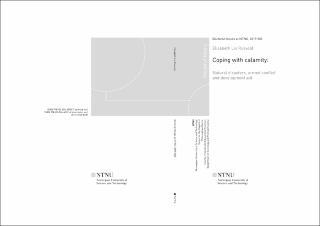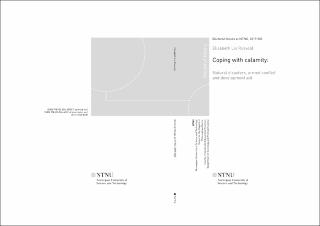| dc.contributor.advisor | Buhaug, Halvard | |
| dc.contributor.advisor | Nordås, Ragnhild | |
| dc.contributor.author | Rosvold, Elisabeth Lio | |
| dc.date.accessioned | 2021-07-08T08:58:19Z | |
| dc.date.available | 2021-07-08T08:58:19Z | |
| dc.date.issued | 2019 | |
| dc.identifier.isbn | 978-82-326-4201-4 | |
| dc.identifier.issn | 1503-8181 | |
| dc.identifier.uri | https://hdl.handle.net/11250/2763886 | |
| dc.description.abstract | Naturkatastrofer, væpnet konflikt og bistand:
Klimaendringene gjør at vi kan forvente både mer intenst og til dels hyppigere forekomst av ekstremvær i fremtiden. Mange av landene som kommer til å bli hardest rammet av dette, er ekstra sårbare for effektene av naturkatastrofer fordi de allerede gjennom en årrekke også har vært rammet av væpnet konflikt. Eksisterende forskning har hittil konsentrert seg om hvorvidt et endret klima kan skape nye konflikter, og fokusert mindre på at disse sammenhengene kan være sirkulære. Det betyr at selv om konflikt øker sårbarhet for ekstremvær, vil også ekstremvær påvirke eventuelle pågående konflikter. Økt kunnskap om dette er viktig på veien for å nå FNs bærekraftsmål.
I avhandlingen ser jeg nærmere på hva som skjer med pågående konflikter når land i konflikt blir rammet av naturkatastrofer. Mer spesifikt undersøker jeg aktørene i konflikten – både myndigheter og opprørsgrupper – og hvordan deres kapasitet til å føre krig kan blir endret når en naturkatastrofe rammer. Naturkatastrofer kan ta liv, ødelegge infrastruktur og gjøre områder ufremkommelige, men de rammer sjelden likt i alle deler av et land og likt for alle aktører. Avhandlingen benytter presise lokasjonsdata for katastrofer, konflikter og bistandsprosjekter, og undersøker hvordan konfliktaktører blir ulikt rammet avhengig av hvor naturkatastrofen finner sted i forhold til områdene der konflikten utspiller seg. Avhandlingen ser også på hvordan utviklingsbistand, som er et av de viktigste verktøyene vi har i møte med katastrofer og konflikt, kan påvirkes av eksisterende konfliktlinjer. Det er tilfelle dersom fordeling av bistand skjer til fordel for myndighetenes støttespillere og på bekostning av sårbare og ofte ekskluderte grupper.
Avhandlingen finner at katastrofer som rammer konfliktområder direkte kan redusere konfliktnivået midlertidig. Dette gjelder spesielt i separatistkonflikter der opprørsgruppene står ansvarlige overfor lokalbefolkningen. I tillegg finner jeg at bistandsprosjekter kan gjøre lokalbefolkningen bedre utstyrt til å takle konsekvensene av ekstremvær. Det forutsetter imidlertid at bistanden når frem til de som trenger den mest, noe som ikke alltid er tilfelle ettersom bistand også fordeles i henhold til politiske konfliktlinjer. Fordi konflikt gjør berørte områder ekstra sårbare for fremtidige klimaendringer, peker funnene i avhandlingen på at konfliktløsning kan være nødvendig for å gjøre utsatte befolkningsgrupper i stand til å takle konsekvensene av et endret klima. | en_US |
| dc.description.abstract | Coping with calamity: Natural disasters, armed conflict and development aid:
Climate change means we can expect more intense and likely more frequent extreme weather in the future. Many of the countries that will be hit hardest are also the ones that will suffer the most from extreme weather and natural disasters because they already experience armed conflicts, some for years at a time. Existing research has focused on how climate might create new conflicts, with little focus on how these relationships are in fact circular. Although conflict can increase vulnerability towards extreme weather, extreme weather can also affect ongoing conflicts. Knowing more about this relationship is an important step towards achieving the UN Sustainable Development Goals.
In the thesis I look more closely at what happens when a country in conflict is hit by a natural disaster. More specifically I investigate the actors in conflict – both governments and insurgents – and how their capacity for waging war can change when a natural disaster occurs. Natural disasters can kill, destroy infrastructure and make areas impassable, but they rarely affect a whole country and its actors equally. The thesis uses precise location data on disasters, conflicts, and aid projects to investigate how conflict actors are affected differently depending on where natural disasters occur and where conflicts take place. The thesis also looks at how development aid projects, one of the most important tools we have in tackling disasters and conflict, can be influenced by existing political cleavages. This is the case if distribution of aid benefits the authorities’ supporters, at the cost of vulnerable and often excluded groups.
This thesis finds that disasters which hit conflict zones directly can temporarily reduce the level of violence. This is especially the case in separatist conflicts where rebel groups are responsible for the local population. In addition, it finds that aid projects can make the local population better prepared to tackle extreme weather. However, this assumes that aid is provided to those who need it the most, which is not always the case, especially when aid is distributed along political cleavages. As conflict makes affected areas especially vulnerable to future climate change, the findings of this thesis indicate that conflict resolution might be necessary for vulnerable populations to cope with the consequences of a changing climate. | en_US |
| dc.language.iso | eng | en_US |
| dc.publisher | NTNU | en_US |
| dc.relation.ispartofseries | Doctoral theses at NTNU;2019:302 | |
| dc.relation.haspart | Paper 1:
Rustad, Siri Camilla Aas; Rosvold, Elisabeth Lio; Buhaug, Halvard.
Development Aid, Drought, and Coping Capacity. Journal of Development Studies 2019 s. 1-16
https://doi.org/10.1080/00220388.2019.1696958 | |
| dc.relation.haspart | Paper 2:
Rosvold, Elisabeth L.
Windows of opportunity?
Natural disasters and the
intensity of armed conflict. | |
| dc.relation.haspart | Paper 3:
Rosvold, Elisabeth Lio; Smidt, Martin.
Fighting the river: Flood impacts
on local conflict dynamics. | |
| dc.relation.haspart | Paper 4:
Rosvold, Elisabeth Lio.
Disaggregated determinants of aid: Development aid projects in the Philippines.
Development Policy Review 2020
https://doi.org/10.1111/dpr.12465
This is an open access article under the terms of the Creative Commons Attribution License (CC BY 4.0) | |
| dc.title | Coping with calamity: Natural disasters, armed conflict and development aid | en_US |
| dc.type | Doctoral thesis | en_US |
| dc.subject.nsi | VDP::Social science: 200::Sociology: 220 | en_US |

